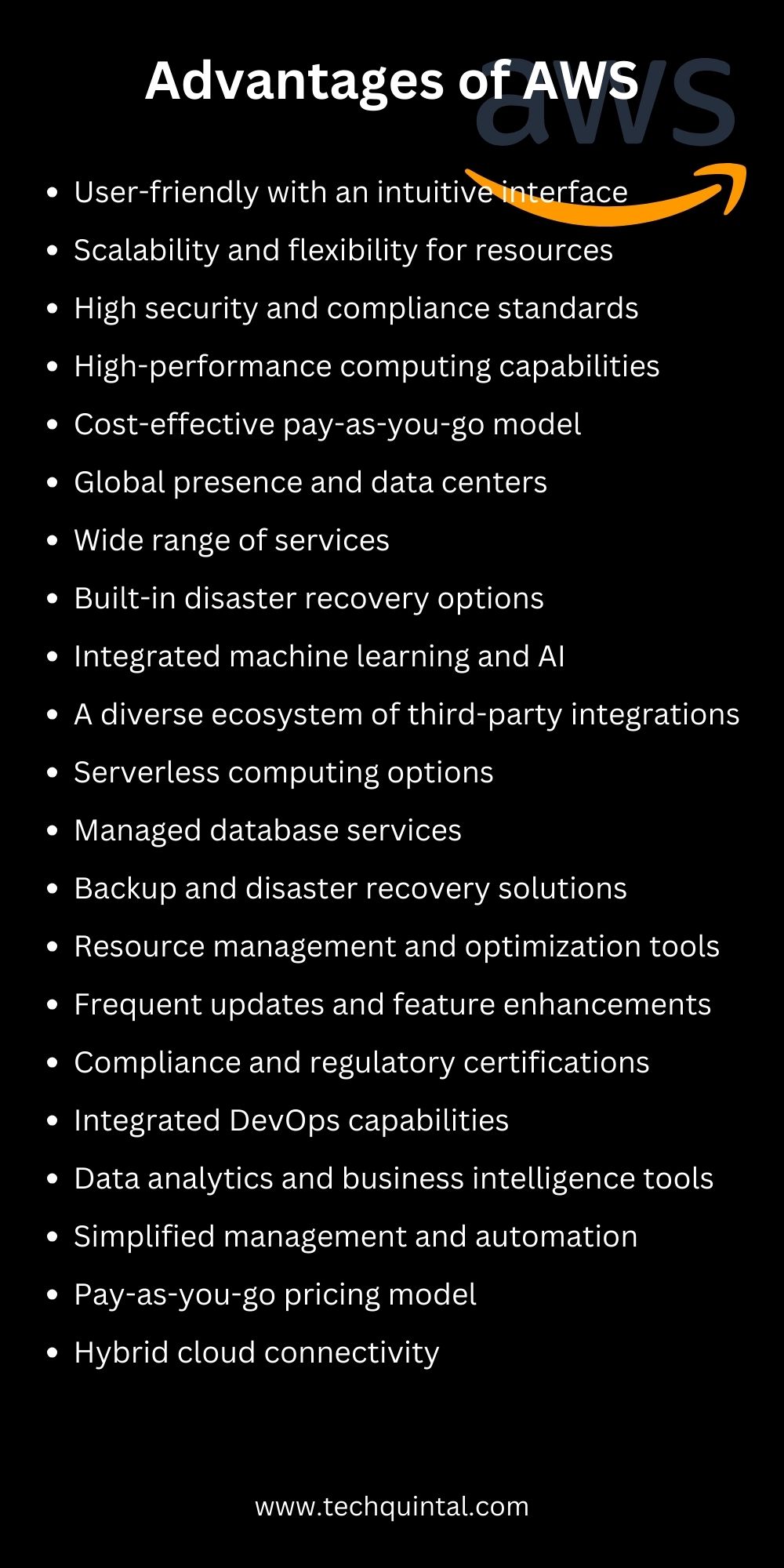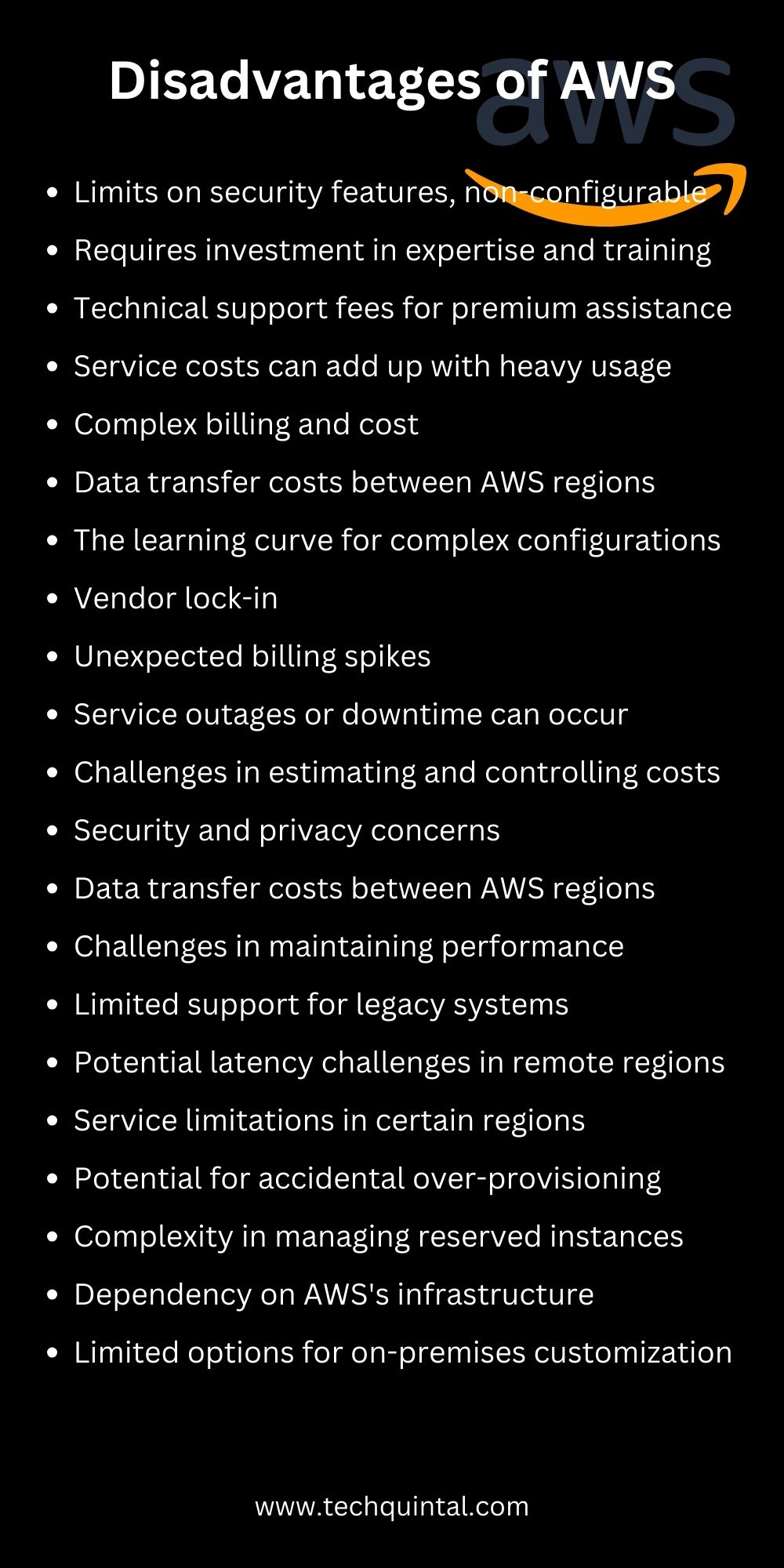
In the highly competitive world we are living in, businesses strive to reach the top. It’s not that easy, but it is feasible. For instance, businesses utilize the pros of cloud computing to make information easily accessible and share it efficiently. Along with this, they use it to reduce human errors and ensure business continuity and disaster recovery. Having said this, we’ll check out one such cloud platform, Amazon Web Services (AWS), employed by small and large-scale industries alike, to see its advantages and disadvantages.
What is AWS?

AWS is a platform offered by Amazon that provides on-demand cloud computing services. This includes services like storage, databases, analytics, machine learning, and even game development tools, all available over the internet.
AWS was launched by Amazon in the year 2002, followed by the AWS cloud products in 2006. It provides scalable and cost-effective cloud computing solutions that include computing power, database storage, content delivery, and media distribution among other operations. Now that you have an idea about AWS, it’s finally time we look at its benefits and drawbacks.
Comparison Table of the Advantages and Disadvantages of AWS
| Advantages | Disadvantages |
|---|---|
| User-friendly with an intuitive interface | Limits on security features, some non-configurable |
| Scalability and flexibility for resources | Requires investment in expertise and training |
| High security and compliance standards | Technical support fees for premium assistance |
| High-performance computing capabilities | Service costs can add up with heavy usage |
| Cost-effective pay-as-you-go model | Complex billing and cost management |
| Global presence and data centers | Potential data transfer costs between AWS regions |
| Wide range of services | The learning curve for complex configurations |
| Built-in disaster recovery options | Vendor lock-in |
| Integrated machine learning and AI | Unexpected billing spikes |
| A diverse ecosystem of third-party integrations | Service outages or downtime can occur |
| Serverless computing options | Challenges in estimating and controlling costs |
| Managed database services | Security and privacy concerns with cloud hosting |
| Backup and disaster recovery solutions | Data transfer costs between AWS regions |
| Resource management and optimization tools | Challenges in maintaining consistent performance |
| Frequent updates and feature enhancements | Limited support for legacy systems |
| Compliance and regulatory certifications | Latency challenges in remote regions |
| Integrated DevOps capabilities | Service limitations in certain regions |
| Data analytics and business intelligence tools | Potential for accidental over-provisioning |
| Simplified management and automation | Complexity in managing reserved instances |
| Pay-as-you-go pricing model | Dependency on AWS’s infrastructure and services |
| Hybrid cloud connectivity | Limited options for on-premises customization |
Advantages of AWS
AWS’s advantages include speed, reliability, and cheapness. When used correctly, it could help you create the best infrastructure for your business. Starting in favor of Amazon Web Services or AWS, here are some of its upsides:

AWS is pretty user-friendly
We know that it depends on the person. However, if we ignore the sheer amount of configuration options available, and considering the flexibility of the platform, it is pretty user-friendly. At least you don’t have to use a console to configure everything.
Big companies take continuous feedback from customers to improve their products and services. The same is with Amazon, where AWS is made more user-friendly with upgrades. AWS Management Console, the intuitive web-based user interface, gives access to all platform resources. It is easy to use, simplifying the process of accessing and managing the AWS account.
In other words, it provides convenience to users by allowing efficient management of resources on the AWS infrastructure.
The platform offers scalability and flexibility
AWS brings scalability to help businesses keep up with customer demands. This includes not only upgrading the infrastructure but also shrinking the resources to match the usage on different timelines. Both vertical and horizontal scaling options are available with AWS, too. A few examples of AWS services facilitating scaling are application load balancer, network load balancer, regions and availability zones, and autoscaling groups.
This is to say, AWS gives flexibility to businesses by allowing them to expand and downsize in line with the traffic and demand. Plus, they only need to pay for the services used, allowing them to keep the infrastructure costs in line with the usage patterns.
It is highly secure
Businesses switch to AWS cloud as it offers them higher security than traditional on-premise configuration. It provides enterprise-level security protection along with encryption. The complete infrastructure includes security protocols and encryption to adhere to high-level security practices. The best part is that it was developed with industrial best practices and government regulations in mind.
Therefore, it covers compliance norms including Health Insurance Portability and Accountability Act (HIPAA), Payment Card Industry (PCI), and System and Organization Controls (SOC).
AWS offers high-performance computing
AWS delivers top-of-the-line computing performance, allowing businesses to solve problems while greatly reducing the time to solution. Its cloud gives access to near-infinite compute and storage resources and has proved successful for running workloads in various industry verticals. A few high-performance computing services of AWS are Amazon EC2 (Elastic Compute Cloud), Elastic Fabric Adapter, NICE DCV, AWS Batch, and AWS ParallelCluster.
This helps maximize operational efficiency by allowing companies to focus on complex problems without brooding over cost and infrastructure constraints. To summarize, it lets businesses innovate quicker with fast networking and virtually unlimited infrastructure.
It provides cost-effective cloud computing solutions
With AWS, businesses can pay only when they consume computing resources, and that too is only for the amount consumed. The traditional way was investing heavily in data centers and servers, where the expected usage and capacity remained unknown.
The shift from fixed to variable expense has proved to be cost-effective for businesses, eliminating the guessing. Firms can afford to innovate more as the cost is significantly lower. Additionally, they can reach business goals and fulfill their needs all the while controlling costs and optimizing spending with AWS. Small businesses can especially benefit from this as AWS fits perfectly with their tight budgets.
Disadvantages of AWS
A big disadvantage of AWS is its support. There is no quick way to get around fixing your issues by contacting AWS support. Most of the benefits of AWS come with a set of drawbacks. Thus, here are the downsides of using AWS.

It limits security features
We mentioned in the security section that AWS is highly secure. This is because it takes several measures to ensure top-notch protection, including setting limitations to some of its features, which cannot be changed. For instance, there are limitations on AWS resources based on regions. Amazon EC2 and Amazon VPC consoles manage these restrictions.
This is to ensure that users don’t end up using too many resources or waste their money. Plus, it acts as a preventive measure, discouraging malicious intent from launching attacks using its resources. Even though AWS limits features, users can still request additional resources when the need arises.
It requires investing in expertise and training
There are several risks associated with migrating to cloud computing. Undoubtedly, Amazon takes care of all these issues, but it is the responsibility of the businesses to use the platform efficiently. The infrastructure of AWS is complex, therefore it requires training and expertise. Businesses using AWS look for hiring professionals to work on this cloud infrastructure, but it’s a hurdle to get the right human resource with the fitting skill set.
Although they can generate massive profits once they find professionals that will help them perform better, the time it takes and the cost it incurs become drawbacks of AWS.
AWS has technical support fees
Businesses love to have backups, ideally an expert team at their disposal just to deal with a crisis if it emerges. But it becomes a liability when the support comes at a cost. A monthly fee for AWS undoubtedly includes support, but it is quite inflexible. Users will have to opt for paid support packages for immediate and intensive assistance.
The pricing for support varies based on the package selected which includes Developer, Business, and Enterprise. The developer support package costs more than $29 or 3% of monthly AWS charges. In contrast, the business support package is priced at $100 or:
- 10% of monthly AWS charges for the first $0–$10K
- 7% of AWS charges on a monthly basis from $10K–$80K
- 5% of AWS charges per month from $80K–$250K
- 3% of monthly AWS charges over $250K
Lastly, the enterprise support package has a price of whichever is higher, $15,000 or:
- 3% of monthly AWS charges over $1M
- 5% of AWS charges per month from $500K-$1M
- 7% of monthly AWS charges from $150K-$500K
- 10% of monthly AWS charges for the first $0-$150K